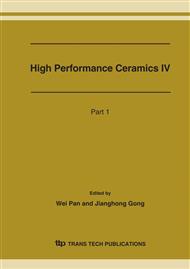[1]
M. Marinšek, K. Zupan and J. Maček: J. Power Sources Vol. 86 (2000), p.383.
Google Scholar
[2]
J-H. Lee, H. Moon, H. -W. Lee, et al.: Solid State Ionics Vol. 148 (2002), p.15.
Google Scholar
[3]
M. Mori, Y. Hiei and H. Itoh: Solid State Ionics Vol. 160 (2003), p.1.
Google Scholar
[4]
T. Matsushima, H. Ohrui and T. Hirai: Solid State Ionics Vol. 111 (1998), p.315.
Google Scholar
[5]
S.T. Aruna, M. Muthuraman and K.C. Patil: Solid State Ionics Vol. 111 (1998), p.45.
Google Scholar
[6]
H. Koide, Y. Someya and T. Yoshida: Solid State Ionics Vol. 132 (2000), p.253.
Google Scholar
[7]
S.P. Jiang, P.J. Callus and S.P.S. Badwal: Solid State Ionics Vol. 132 (2000), p.1.
Google Scholar
[8]
D. Kek and P. Panjan: J. Euro. Ceram. Soc. Vol. 21 (2001), p.1861.
Google Scholar
[9]
N. Bamba, Y. -H. Choa, T. Sekino, K. Niihara: Solid State Ionics Vol. 111 (1998), p.171.
Google Scholar
[10]
H. Kondo and T. Sekino: Mater. Lett. Vol. 57 (2003), p.1624.
Google Scholar
[11]
K. Jensen, S. Primdahl, I. Chorkendorff, et al.: Solid State Ionics Vol. 144 (2001), p.197.
Google Scholar
[12]
D. Sciti and A. Bellosi: J. Euro. Ceram. Soc. Vol. 21 (2001), p.45.
Google Scholar
[13]
J.Q. Li, X.R. Zeng, Tang J N and Xiao P: J. Euro. Ceram. Soc. Vol. 23 (2003), p.1847.
Google Scholar
[14]
D. Simwonis, H. Thülen, F.J. Dias, et al.: J. Mater. Proc. Technol. Vol. 92 (1999), p.107.
Google Scholar
[15]
G.Q. Shao, M. Pan, S.C. Jia, et al.: Chinese Invention Pat No. ZL 94 1 20137. 6. Dec. 29, (1994).
Google Scholar
[16]
A.S. Carrillo, T. Tagawa and S. Goto: Mater. Res. Bull. Vol. 36 (2001), p.1017.
Google Scholar
[17]
D. Sporn, J. GroBmann and A. Kaiser: Nanostruc. Mater. Vol. 6 (1995), p.329.
Google Scholar
[18]
S. -J. Kim, W. Lee and W. -J. Lee: J. Mater. Res. Vol. 16 (2001), p.3621.
Google Scholar
[19]
T. Kawada, N. Sakai and H. Yokokawa: Solid State Ionics Vol. 53 (1992), p.418.
Google Scholar
[20]
A. Tsoga, A. Naoumidis and P. Nikolopoulos: Acta Mater. Vol. 44 (1996), p.3679.
Google Scholar
[21]
G.Q. Shao, J.R. Xie, X.L. Duan, et al.: Chinese Invention Pat No. ZL 02 1 15711. 1. Apr. 12, (2002).
Google Scholar
[22]
G.Q. Shao, H. Cai, J.R. Xie, et al.: Mater. Lett. Vol. 57 (2003), p.3287. Fig. 5. Conductivity vs. temperature of YSZ-NiCr cermet.
Google Scholar


